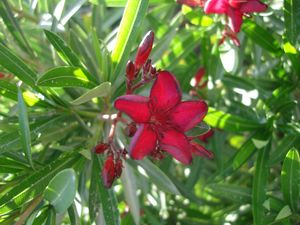Print This Page
Oleander, Dwarf
Nerium oleander 'cv.'
Oleander is a popular evergreen blooming landscape shrub that presumably originated from Asia; in the genus Nerium, it is the only species with over 400 cultivars accounted for. A popular choice due to its rapid growth habit, marvelous blooms, and tolerance to drought and poor soils.
Oleander sends out large erect stems outward from its base in every direction. The leaves are arranged in whorls around the branches, bright to dark green, thick and leathery reaching up to six inches in length. The dwarf cultivars leaves are slightly smaller, and overall the plant matures at five feet. Every spring, clusters of flowers up to one and a half inches in diameter emerge on the tips of new branches, persisting for several weeks, and then continue to emerge sporadically throughout the season. The fruits that follow are long narrow capsules that contain numerous seeds.
Oleander is one of the most poisonous landscape plants available – every part of the plant is toxic. Lately, it has had serious issues with bacterial blight, which is easily cultivated in areas without good air circulation or high moisture. The first stages result in black and brown spots on the leaves, followed by total defoliation of stems. Once canker growths are forming on the stems, it’s too late to try and save. The bacteria will remain in the soil, so any new oleanders that are planted there will surely get the disease again.
 |
Blooming Hedge |
 |
Medium Border |
Flower Color:Red, Pink, Or White
|
 |
Height:3-5 Feet
|
 |
Spread:3-5 Feet
|
 |
|
Interesting Notes
Entire plant is toxic
USDA Hardiness Zone 8b
Characteristics & Attributes
|
Deer Tolerance
|
Exposure
|
Habit
|
Water Needs
|






